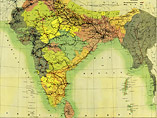 About the collection
About the collection
Disease: Plague
The Medical History of British India collection reveals the political effects of plague on the Indian state in the late 19th century.
Although there are references to a disease similar to bubonic plague in the 17th and 19th centuries, the first official acknowledgment of the existence of bubonic plague date to 1896. The plague was probably imported from Hong Kong, where an epidemic had been seething since 1894.
Its initial impact was limited to port cities, particularly Bombay, but later also Pune, Calcutta and Karachi. By 1899, it had appeared in many smaller towns and had a growing regional impact as it spread out into the countryside. The demographic impact of plague epidemics was felt most in western and northern India – in the provinces of Bombay, Punjab and the United Provinces. Eastern and southern India were not as badly affected.
Political impact
Although the cost in human lives of the plague in India was great, historians have argued that the significance of the plague epidemics lies more in its political impact and what it tells us about the organisation and priorities of public health in British India. The colonial state's efforts to prevent the spread of plague within India should be seen within the broader context of international efforts to impose quarantine to prevent the spread of epidemic diseases such as cholera and plague along international trade routes.
The international pressures on the British Indian government to control the spread of epidemics diseases within India contributed to the implementation of measures at an unprecedented scale. These measures, implemented in the western Indian coastal cities of Bombay and Poona were considered culturally intrusive and offensive. These brought on a flurry of protests from Indians, leading to riots in some parts of eastern and western India and widespread evasion of official measures for containing the epidemic.
Plague control policy
The years 1898-1899 marked a turning point in the government's strategies of plague control due to an increasing realisation that the use of force in enforcing plague regulations was proving counter-productive and that it would be administratively impossible to enforce them in the large area affected by the epidemic, especially since plague was no longer confined to cities but had spread into the countryside. A further change in policy included the incorporation of practitioners of indigenous systems of medicine in plague prevention. This marked a turnaround, as Indian systems of medicine were considered unscientific and disparaged by the state. Inoculation using Haffkine's plague vaccine was also pressed, although the government made strenuous efforts to stress that inoculation was not compulsory.
The response of the British Indian state to the late 19th-century plague epidemics was marked by the exceptionally intrusive measures enforced using colonial state power and starkly revealed the political constraints on medical intervention in India. As such, they are considered by historians to be formative moment in the development of public health in India.




